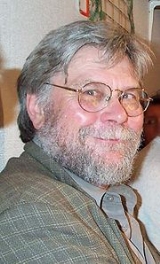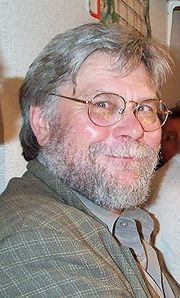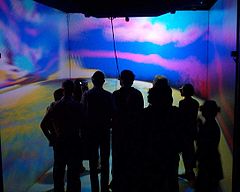
Daniel J. Sandin
Encyclopedia

Computer graphics
Computer graphics are graphics created using computers and, more generally, the representation and manipulation of image data by a computer with help from specialized software and hardware....
artist/researcher. He is a Professor Emeritus of the School of Art & Design, University of Illinois at Chicago
University of Illinois at Chicago
The University of Illinois at Chicago, or UIC, is a state-funded public research university located in Chicago, Illinois, United States. Its campus is in the Near West Side community area, near the Chicago Loop...
, and Co-director of the Electronic Visualization Laboratory
Electronic Visualization Laboratory
The Electronic Visualization Laboratory is a cross-disciplinary research lab at the University of Illinois at Chicago. It brings together faculty and students from the Art and Computer Science departments of UIC...
at the University of Illinois at Chicago. He is an internationally recognized pioneer in computer graphics, electronic art and visualization
Scientific visualization
Scientific visualization is an interdisciplinary branch of science according to Friendly "primarily concerned with the visualization of three-dimensional phenomena , where the emphasis is on realistic renderings of volumes, surfaces, illumination sources, and so forth, perhaps...
.
Biography
Dan Sandin received his B.A. in Natural Sciences from Shimer CollegeShimer College
Shimer College is a very small, private, undergraduate liberal arts college in Chicago, Illinois, in the United States. Founded by Frances Wood Shimer in 1853 in the frontier town of Mt. Carroll, Illinois, it was a women's school for most of its first century. It joined with the University of...
, IL in 1964 and his M.S. in Physics
Physics
Physics is a natural science that involves the study of matter and its motion through spacetime, along with related concepts such as energy and force. More broadly, it is the general analysis of nature, conducted in order to understand how the universe behaves.Physics is one of the oldest academic...
from the University of Wisconsin–Madison
University of Wisconsin–Madison
The University of Wisconsin–Madison is a public research university located in Madison, Wisconsin, United States. Founded in 1848, UW–Madison is the flagship campus of the University of Wisconsin System. It became a land-grant institution in 1866...
in 1967. He became interested in video
Video
Video is the technology of electronically capturing, recording, processing, storing, transmitting, and reconstructing a sequence of still images representing scenes in motion.- History :...
in 1967, while helping to organize student demonstrations at the University of Illinois.
In 1969, he moved from the University of Wisconsin–Madison to the University of Illinois at Chicago after his presentation at the Smithsonian
Smithsonian Institution
The Smithsonian Institution is an educational and research institute and associated museum complex, administered and funded by the government of the United States and by funds from its endowment, contributions, and profits from its retail operations, concessions, licensing activities, and magazines...
of "Glowflow", a computer controlled light and sound system, created with Myron Krueger. His major achievements were a series of projects Glowflow (1969), Sandin Image Processor (IP) (1971–1973), Sayre Glove (1977), PHSColograms (1988), CAVE (1991) and ImmersaDesk and Infinity Wall.
Dan Sandin received several awards. The Guggenheim Fellowships awarded in 1978, the National Endowment for the Arts in 1980, the Rockefeller Foundation Video Fellowship in 1981, the Inventor of the Year from the University of Illinois in 2000 and the Rockefeller Foundation Media Arts Fellowship in 2002.
Work
Dan Sandin has said that his career has three main objectives:- the design of electronic instruments for visual performance and personal growth;
- the development of educational facilities and programs related to the use of electronic screens; and
- the production and exhibition of visual works for personal expressive reasons.
Sandin Image Processor
From 1971 to 1973, he designed the Sandin Image ProcessorSandin Image Processor
The Sandin Image Processor is a video synthesizer, usually introduced as the "video equivalent of a Moog audio synthesizer," invented by Dan Sandin. That is, it accepted basic video signals and mixed and modified them in a fashion similar to what a Moog synthesizer did with audio...
, a patch programmable analog computer
Analog computer
An analog computer is a form of computer that uses the continuously-changeable aspects of physical phenomena such as electrical, mechanical, or hydraulic quantities to model the problem being solved...
for real-time manipulation of video inputs through the control of the grey level information. This modular design was based on the Moog synthesizer
Moog synthesizer
Moog synthesizer may refer to any number of analog synthesizers designed by Dr. Robert Moog or manufactured by Moog Music, and is commonly used as a generic term for older-generation analog music synthesizers. The Moog company pioneered the commercial manufacture of modular voltage-controlled...
. With Tom DeFanti, he would combine it with real-time computer graphics and synthesized music and perform visual concerts. He has performed worldwide and has received grants in support of his work from the Rockefeller Foundation
Rockefeller Foundation
The Rockefeller Foundation is a prominent philanthropic organization and private foundation based at 420 Fifth Avenue, New York City. The preeminent institution established by the six-generation Rockefeller family, it was founded by John D. Rockefeller , along with his son John D. Rockefeller, Jr...
(1981), the National Science Foundation
National Science Foundation
The National Science Foundation is a United States government agency that supports fundamental research and education in all the non-medical fields of science and engineering. Its medical counterpart is the National Institutes of Health...
, the National Endowment for the Arts
National Endowment for the Arts
The National Endowment for the Arts is an independent agency of the United States federal government that offers support and funding for projects exhibiting artistic excellence. It was created by an act of the U.S. Congress in 1965 as an independent agency of the federal government. Its current...
(1980) and the Guggenheim Foundation
John Simon Guggenheim Memorial Foundation
The John Simon Guggenheim Memorial Foundation was founded in 1925 by Mr. and Mrs. Simon Guggenheim in memory of their son, who died April 26, 1922...
(1978). His piece "Spiral PTL" was one of the first pieces included in the Museum of Modern Art
Museum of Modern Art
The Museum of Modern Art is an art museum in Midtown Manhattan in New York City, on 53rd Street, between Fifth and Sixth Avenues. It has been important in developing and collecting modernist art, and is often identified as the most influential museum of modern art in the world...
's video art collection.
The Sayre Glove
In 1977, with Tom DeFanti and Rich Sayre, he designed the Sayre Glove, the first data gloveWired glove
A wired glove is an input device for human–computer interaction worn like a glove.Various sensor technologies are used to capture physical data such as bending of fingers. Often a motion tracker, such as a magnetic tracking device or inertial tracking device, is attached to capture the global...
, as part of a grant from the National Endowment for the Arts. This device used light based sensors with flexible tubes with a light source at one end and a photocell at the other. As the fingers were bent, the amount of light that hit the photocells varied, thus providing a measure of finger flexion. It was mainly used to manipulate sliders, but was lightweight and inexpensive.
PHSColograms
By 1988, Sandin was working on a type of digital photography called PHSColograms; a system whereby a number of still images were situated in an autostereoscopicAutostereoscopy
Autostereoscopy is any method of displaying stereoscopic images without the use of special headgear or glasses on the part of the viewer. Because headgear is not required, it is also called "glasses-free 3D" or "glassesless 3D"...
manner and back-projected with light. The effect was very similar to holograms and many times viewers would mistake them as such. The initial system supported roughly 13 images but further improvements now could easily allow 100 such images to be used. This system was designed primarily for use in the medical field where these quasi-3D images could benefit surgeons.
Cave Automatic Virtual Environment

Thomas A. DeFanti
Tom DeFanti is a computer graphics researcher and pioneer. His work has ranged from early computer animation, to scientific visualization, virtual reality, and grid computing...
and graduate students, he designed the CAVE
Cave Automatic Virtual Environment
A Cave Automatic Virtual Environment is an immersive virtual reality environment where projectors are directed to three, four, five or six of the walls of a room-sized cube...
system. This is an immersive system that is the current standard for Virtual Reality
Virtual reality
Virtual reality , also known as virtuality, is a term that applies to computer-simulated environments that can simulate physical presence in places in the real world, as well as in imaginary worlds...
systems. The normal full system consists of projections screens along the front, side and floor axes, and a tracking system for the "user". Although they used the recursive acronym Cave Automatic Virtual Environment for the CAVE system, the name also refers to Plato
Plato
Plato , was a Classical Greek philosopher, mathematician, student of Socrates, writer of philosophical dialogues, and founder of the Academy in Athens, the first institution of higher learning in the Western world. Along with his mentor, Socrates, and his student, Aristotle, Plato helped to lay the...
's "Republic" and "The Allegory of the Cave" where he explored the concepts of reality and human perception.
Since then there have been a couple off-shoots of the CAVE technology: ImmersaDesk and Infinity Wall. The ImmersaDesk is a semi-immersive system, resembling a drafting table, while the Infinity Wall is designed to cater to an entire room of people, such as a conference room.
Works
- 1973. "5 Minute Romp through the Image Processor". With Phil Morton.
- 1975. "Wandawega Waters".
- 1974. "Poop for the NCC". With Tom DeFanti.
- 1974. "Triangle in Front of Square in Front of Circle in Front of Triangle".
- 1980. "Spiral PTL". With Tom Defanti and Mimi Shevitz, in the collection of the Museum of Modern Art in New York.
- 1990. "A Volume of Two-Dimensional Julia Sets".
- 1995. "The Kinetic Sculpture Garden".
- 1996. "The Oort Continuum".
- 1997. "Poverty Island With Video Skies".
- 1999. "From Death's Door to the Garden Peninsula".
- 2001. "Alive on the Grid".

